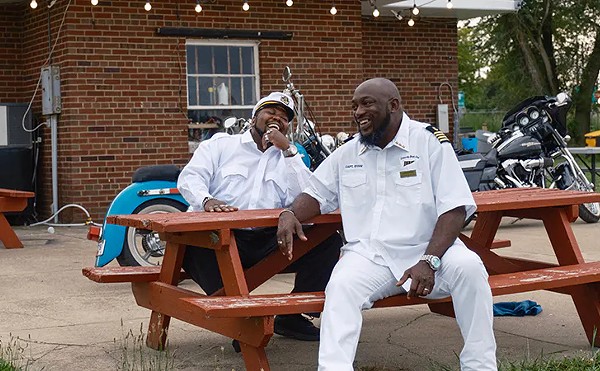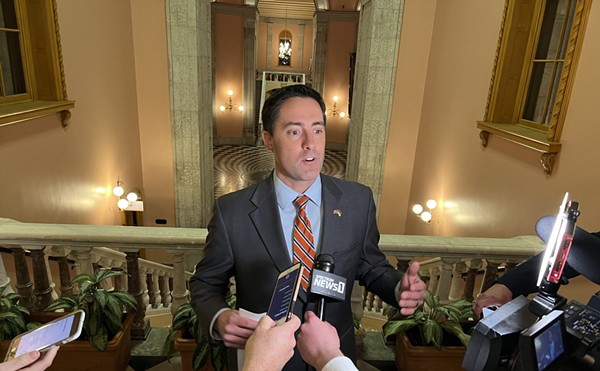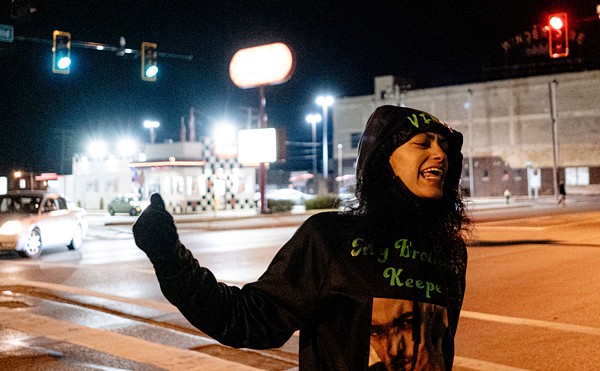Operation Magnus is now in full effect. That means six thousand people per day are being vaccinated against Covid-19 at the Cleveland State University Wolstein Center, on the very same basketball court where the NCAA tourney-stamped Vikings clawed their way to eight of their 16 regular season victories, en route to a Horizon League Championship.
The mass vaccination site is the largest in Ohio and the only one sponsored by the Federal government. It is already Northeast Ohio’s marquee theater in what Gov. Mike DeWine has consistently characterized as a war with the coronavirus. DeWine has said he wants to vaccinate as many Ohioans as possible as soon as possible. Operation Magnus will help the state do so “effectively, efficiently and equitably.”
(CSU President Harlan Sands, for the record, who last week got his presidential contract extended to 2026, appears to be the only local, state or federal official referring to the effort as “Operation Magnus,” bless his heart. We see no reason not to join him.)
The Wolstein site was selected by the state of Ohio with input from area health officials, who were insistent on prioritizing access via public transit and proximity to populations with above average social vulnerabilities, as determined by the Centers for Disease Control. Of the 25,000 people who live within one mile of the Wolstein Center, 65% belong to historically marginalized communities; 45% live below the poverty line.
The site was organized and assembled in a brisk two weeks with financial, logistical and personnel support from the Federal Emergency Management Agency (FEMA). That support came courtesy of President Joe Biden, who has authorized a number of similar mass vaccination sites nationwide. The Wolstein site, or “megapod,” with uniformed military personnel at every entrance, brings a taste of disaster relief to Northeast Ohio.
By the end of its eight-week run, an estimated 210,000 people will have been vaccinated with either the two-dose Pfizer or single-dose Johnson & Johnson vaccine. That figure is over and above the weekly allotment of doses provided to the state by the Feds.
If you’ve registered for your shot by phone or online, the process at Wolstein is designed to be fast and frictionless. If you need transportation, for example, you’ll have access to a free all-day transit pass, which RTA has provided with money from an ODOT grant and which can be accessed by calling the United Way 2-1-1 line. If you arrive by car, you’ll park in a free parking space at one of several lots in the immediate vicinity of the arena. Volunteers will be on hand providing directions and whisking vehicles through the entrances and exits. Depending on where you disembark, you’ll then take a free shuttle to the gates of Wolstein, (also provided by RTA with ODOT grant money).
You’ll wait briefly in an outdoor line, get your temperature checked upon entry, and then process around the concourse and down to the arena’s floor, where nearly 500 chairs will have been set up at an appropriate physical distance.
Once seated, one of 32 masked and uniformed soldiers tasked with administering the vaccine will arrive at your side to jab your arm. You’ll wait about 15 minutes, to ensure that you’re not experiencing side effects. If you have questions, and you don’t speak English, on-site translators who speak Spanish, French, Russian, Arabic and Mandarin can be summoned at a moment’s notice.
Once you’re cleared, you will exit out the arena’s other side. Another soldier will promptly disinfect your seat for the next in line. If you’re receiving the Pfizer vaccine, you’ll have been automatically scheduled for your second dose at roughly the same time on the same day three weeks later. The site will administer the Johnson & Johnson vaccine during its final two weeks of operation.
From start to finish, the process is meant to take less than an hour, and early reports from those who were vaccinated in the site’s opening days suggest that things are moving even more quickly than that. In informal conversations conducted outside the arena, and in celebratory social media posts, the consensus among those who’d received shots was that the level of efficiency was elite, ditto the level of volunteer friendliness. Everything far exceeded expectations.
The volunteers confirmed the exuberant vibes to Scene.
“People are amped up,” a CSU student volunteer told Scene. “They walk through this tent at the beginning, and it feels like you're getting on a carnival ride or something.”
As the site was ramping up to full capacity last week — from 1,500 shots on Tuesday, to 3,000 on Wednesday, to 4,500 on Thursday and finally to 6,000 on Friday, where it will remain — soldiers from the U.S. Army’s 101st Airborne Division out of Fort Cambpell, Kentucky, and National Guardsmen out of Brook Park were constantly evaluating operations to enhance efficiencies, Brigadier General Rebecca O’Connor told the media. The operation is now humming, administering more than 400 shots per hour every day from 8 a.m. to 8 p.m.
Last Tuesday, at a socially distant press event coinciding with the site’s “soft launch,” Gov. DeWine announced that the state’s estimated supply of vaccine doses was expected to increase significantly the week of March 29. Through the month of March, the state has been receiving about 400,000 doses per week. On the week of March 29, available doses could be 500,000 or more.
Bearing the increase in mind, and on the advice of county health directors across Ohio, who want to ensure that no vaccine goes to waste, DeWine announced expanded eligibility. Doses had been initially targeted at the state’s oldest and most vulnerable residents.
“We’ve always had one goal,” DeWine said, “to save lives. That’s why we started in our nursing homes and with people 80 and above. But we also have the moral imperative to ensure that no shots are just sitting someplace, that they get used as soon as possible.”
Last Friday, all Ohioans over 40 and those with an expanded list of medical conditions, including cancer and obesity, became eligible. On March 29, when the supply is expected to increase, all Ohioans 16 and older will become eligible.
Dr. Lynn Milliner, who spoke to Cleveland City Council about the mass vaccination site and the various available vaccines last week, expressed optimism about the state’s prospects while also encouraging residents to remain vigilant.
“There’s a light at the end of the tunnel,” she said. “But we’re still in the tunnel.”
Far and away the most important concern articulated by agency partners in remarks about Operation Magnus was the equitable distribution of the vaccine. This was an echo and extension of federal messaging. It became apparent early on that despite the intentionality of the Wolstein Center’s location, and targeted outreach, far more white people were registering for appointments than people of color.
“That has to change!” County Executive Armond Budish exclaimed at a press conference, forever sounding like he’s talking to third graders. “It comes down to a matter of life and death!”
Budish said that the site’s accessibility and free transit passes are important, but they only go so far. Vulnerable communities face other challenges to scheduling appointments. One of the biggest, he said, is trust.
“Lots of people, particularly Black and brown people, don’t trust the government and they don’t trust vaccines,” he said.
To combat that skepticism, the county has partnered with a number of nonprofit organizations to “talk to their folks” in the hopes that information about the vaccine can be delivered from trusted sources.
Gov. DeWine said that at least 300 agencies in Cuyahoga County have been doing this work. He mentioned the Urban League of Greater Cleveland, the Cleveland NAACP, Global Cleveland, the Hispanic Roundtable, and a number of faith-based groups. (Budish even quipped that if the Wolstein site vaccinated all the people that Gov. DeWine has thanked, that would cover about half of Cuyahoga County.)
These outreach efforts coincide with more active, and still developing, programs and events to bring the vaccine to residents, including seniors, those experiencing homelessness and those without internet access. The City of Cleveland, for example, has had mobile pods vaccinating seniors in high-rise housing facilities for several weeks. The Cuyahoga County Board of Health recently vaccinated 350 people in East Cleveland in partnership with the Salvation Army and more than 1,600 at a recent event at the Word Church in Warrensville Heights. MetroHealth, with doses provided by the City of Cleveland, has been vaccinating those experiencing homelessness at multiple shelters.
At Wolstein, every day, a portion of the available vaccines are being set aside for vulnerable communities. Some, DeWine said, would be reserved for churches and other groups. While the site will not take walk-ins, Brigadier General Rebecca O’Connor said that people can arrive in person to schedule a shot at a later date. If appointments are canceled, those on a waiting list will be contacted to ensure that no shot goes unused. (Cleveland’s 17 city council members were also promised 50 doses each, to be used for those in their wards.)
Kevin Sly, FEMA’s regional administrator on site at Wolstein, spoke last week about the efforts to vaccinate residents with equity in mind. He described Operation Magnus as an explicit effort to vaccinate those most in need.
“The Wolstein Center does not only provide the necessary space and structure to administer 6,000 doses per day,” he said. “It is uniquely situated to support medically underserved communities in the city.”
Sly, as a Black man, stressed the importance of communicating to Black people the need to get vaccinated.
“As an African-American with at least three comorbidities, I decided to take the shot,” Sly said. “It was not an easy decision for me, but it was one I knew I had to take. My grandmother, my mother, my uncle, my cousin and my twin sister got Covid-19 back in March of last year and I was extremely scared for the outcome. This is the number-one priority for people of color and for all Ohioans. It is imperative that you all get the shot, especially those communities that have been hit the hardest with Covid-19.”
The good news is that every day an increasing number of Ohians are getting vaccinated. As of last Wednesday, more than 2.4 million across the state had received their first dose, and 2/3rd of Ohioans older than 70 were vaccinated.
Gov. DeWine, having toured the Wolstein site with his wife Fran and spoken with folks receiving shots, said that the “universal response” was one of relief and happiness.
That corresponds with comments made to Scene.
“Quick, easy,” reflected one man outside Wolstein after his first dose. “Painless” said another on Twitter. (No one personally told Scene that they were looking forward to hugging their relatives again, but reporting by other local outlets illustrated just how eager folks are to hug their friends and families after a year of isolation.)
Wolstein is one of more than 1,300 locations across the state where Ohioans may be vaccinated, and while it’s by far the largest option locally, there are 150 other providers scheduling appointments in Cuyahoga County. DeWine estimated that by the end of the month, there would be a total of 15 mass vaccination sites in Ohio. Very soon, it would seem, there will be more supply than demand.
CSU President Harlan Sands said he was bowled over by the leadership he saw on display in the setup of the Wolstein site, particularly from National Guard Brigadier General Rebecca O’Connor, whom he called “the power” behind Operation Magnus.
It was O’Connor, in fact, according to CSU media relations, who christened the operation after CSU’s mascot. It’s technically “Joint Task Force Magnus,” not “Operation Magnus.” And O’Connor selected the name, per a CSU spokesperson, “in honor of CSU and the quality and level of support we are providing, and to recognize our men’s basketball team’s Horizon League win.”















